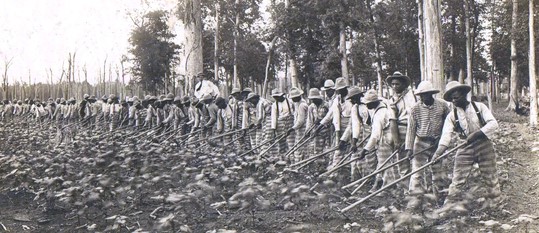Mississippi State Penitentiary is less than an hour drive from where Emmett Till was murdered. One of three state prisons administered by the Mississippi Department of Corrections, it is also known as Parchman Penal Farm because it was owned by a prominent Sunflower county family, whose patriarch, J. M. Parchman, was the first warden. The Mississippi State Penitentiary (MSP) is the state’s oldest penal institution. It begun in 1901 with four stockades constructed largely by state prisoners. It was originally comprised of three separate farms: a small farm, maintained by white convicts, a smaller one, farmed by women (mostly black), and a huge sprawling plantation for the prison’s black convicts who were the vast majority of the inmates. It has over 18,000 acres and covers an area of 46 square miles. The Parchman prison farm system became operational in 1905.
Some of its most famous prisoners included Elvis Presley’s father Vernon, who was imprisoned in 1938 for check forgery; and blues singers Bukka White (also known as Booker T. Washington White) who served three years in 1937 for shooting a man in the leg. White composed his famous “Parchman Farm Blues,” which warned young men about the horror of the prison.
In 1904 the Mississippi Department of Corrections implemented a policy of leasing its prisoners to private businesses who needed cheap labor. Prisoners picked cotton from dawn to dusk and built tunnels using dynamite. Modeled after an antebellum slave plantation, its three founding principles were: the prison must profit at any cost, armed inmates were effective, low-cost, guards, and corporal punishment was an acceptable means of control.
In the book entitled, ‘Worse Than Slavery: Parchman Farm and the Ordeal of Jim Crow Justice‘, David Oshinsky chronicles the history of Parchman Farm, which he describes as “…the closest thing to slavery that survived the civil war.” According to Oshinsky, Parchman’s past contains evidence that inmates were stabbed, raped, beaten, and systematically abused by being forced at gunpoint to labor until exhaustion in the cotton and soybean fields. Corporal punishment was routinely administered for not meeting work quota and prisoners were beaten with a whip nicknamed, “Black Annie.”
In 1942, the prison ended the practice of convict leasing. The state prison reform act of 1964 banned the use of the lash. Mechanical equipment was purchased to increase agricultural yields and ease the physical toll of farm work. Vocational training and job counseling were offered for the first time.
A 1971 lawsuit filed by four Parchman inmates against the prison superintendent alleged that living quarters at Parchman were infested with maggots and rats, that raw sewage was dumped in open spaces on the farm and that inmates were overworked, underfed, denied medical care and subjected to routine violence.
Federal Judge William Keady agreed. In his 1972 decision he called for an immediate end to the unequal treatment of black inmates at Parchman, who made up two-thirds of the prison population. The court found that: twice the number of blacks were required to live in the same amount of dormitory space as white inmates, black inmates were subjected to greater punishment or more severe discipline than white inmates for similar infractions, and that the prison practiced racial segregation, contrary to the law of the United States.

